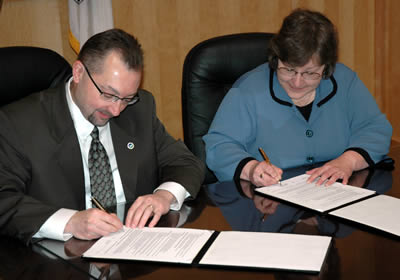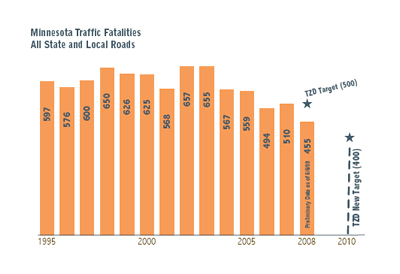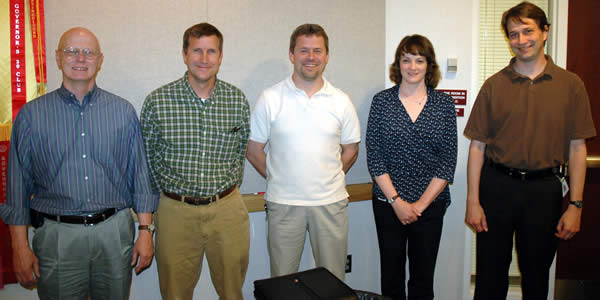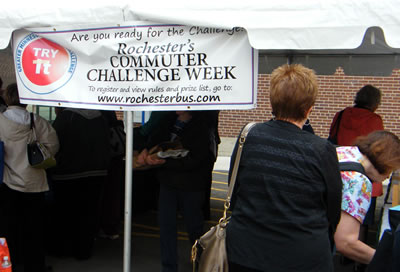 |
|

|
 |
TABLE of CONTENTS
 |
Mn/DOT signs historic agreement with northern Minnesota tribe |
By Nick Carpenter

Commissioner Tom Sorel and Karen Diver, Fond du Lac Band of Lake Superior Chippewa tribal chair, signed a memorandum of understanding May 15 to partner in eliminating unwanted plant life along state highways within the boundaries of the Fond du Lac Reservation. Photo by Kevin Gutknecht |
For the first time in Minnesota’s 151-year history, a state agency will work cooperatively with a Native American tribe in the management of roadside vegetation.
Under terms of a memorandum of understanding signed on May 15, Mn/DOT will partner with the Fond du Lac Band of Lake Superior Chippewa to combat unwanted plant life along state highways within the boundaries of the Fond du Lac Reservation.
“This agreement exemplifies the importance of tribes and road authorities in Minnesota working together,” said Linda Aitken, tribal liaison, Office of Government Affairs. “It will likely set a national precedence.”
The MOU honors the tribe’s control of the use of herbicides within its reservation and defines goals, understandings, needed support and essential resources agreed upon by both parties. Some of the agreements include:
- Sharing spatial information on culturally significant areas, wetlands and other bodies of water within the reservation
- Partnering to re-evaluate the site of applied herbicides post-application and mechanically remove invasive plants in areas where FDL does not want herbicides used
Maintenance crews generally use a combination of mechanical, biological and chemical techniques to control weeds and maintain vegetation along state highways.
FDL expressed concern over the use of herbicides and the loss of culturally significant plants and plant habitat when new populations of invasive weeds were found along Highway 2, Highway 210 and Interstate 35 on Mn/DOT rights of way within the reservation. The department decided to discontinue the application of herbicides within the reservation.
Although the MOU is not a binding contract, it will be actively practiced through January 2010, at which time the results of the agreement will be reviewed by both parties.
Employees interested in viewing the entire MOU, can do so by visiting http://www.dot.state.mn.us/mntribes/.
|
 |
|

|
 |
TABLE of CONTENTS
 |
Governor vetoes transportation policy bill |
By Jeanne Aamodt
While supporting several provisions within the bill, Gov. Tim Pawlenty last week agreed with Mn/DOT's recommendation and vetoed the 2009 Omnibus Transportation Policy bill.
“Our chief concerns were about rail provisions that could have prematurely selected specific routes, stops or endpoints of passenger rail service between Chicago and the Twin Cities,” said Scott Peterson, Government Affairs director.
Peterson said Mn/DOT staff also had concerns about language regarding railroad employees when the state currently does not operate a railroad and the completion of environmental impact statements for Highway 14 when the department cannot control the actions of other agencies involved in the development of an EIS.
“The bill contained provisions of transportation policy that were problematic, like directives related to individual highway projects, or premature like the passenger rail language which would have pre-established conditions before all corridors and routes are evaluated and a rail operations structure established,” Peterson said. “Hopefully, we'll make progress on these issues and take them up again in the 2010 session.”
In related news, the governor signed the stand-alone seat-belt legislation that allows police to pull over drivers for not wearing seat belts without any other offense. This law fulfills a longtime objective of the Minnesota Toward Zero Deaths partnership, which includes Mn/DOT and the Department of Public Safety among other government agencies.
“The seat-belt law takes effect June 9. Not only is it a major safety measue, it also helps the state secure additional federal transportation funding that would otherwise be denied,” said Peterson. “With the primary seat-belt law, about $3.4 million in federal funds will be available in fiscal year 2010.”
For more information on the 2009 legislative session, visit the Government Affairs Web site at http://ihub.dot.state.mn.us/governmentaffairs/legislative2009/. An updated summary of the session will be posted soon.
For information about the transportation funding bill, see the May 13 issue of Newsline.
|
 |
|

|
 |
TABLE of CONTENTS
 |
Performance report documents agency’s priorities, rates its success |
|
By Jeanne Aamodt

Traffic fatalities, one of the areas noted in the 2008 Annual Performance Report, came down sharply from 2004 through 2006, and again in 2008. In 2006 Minnesota met the Toward Zero Death initiative’s 2008 target of reducing fatalities to 500 or less. That same year, Minnesota’s fatality rate (per vehicle miles driven) was second lowest in the nation. |
Mn/DOT has achieved sustained progress in reducing road fatalities, improving state bridge condition and stemming the growth of congestion on Twin Cities freeways, according to the agency’s 2008 Annual Performance Report. The report also says state pavement condition falls short of the agency’s goals.
“We are releasing the performance report to be more transparent and accountable for how we manage the transportation system,” said Commissioner Tom Sorel. “I believe this performance report is one important step in meeting Minnesotans’ expectations.”
In addition to goals set for road fatalities, bridge condition and congestion management, Mn/DOT surpasses performance targets that measure the quality of the local airport system and the average speed on interregional trips.
Tim Henkel, Modal Planning and Program Management Division director, said that Mn/DOT uses performance measures to guide its decisions and stimulate innovation. He said upgrading state highway pavement condition remains a priority, despite financial limitations.
“Mn/DOT is making a conscious effort to meet our performance targets within the limits of financial reality,” Henkel said. “Our approach is to balance our efforts across performance measures. We strive to set targets that meet customer needs, assure safe and sound engineering and achieve long-term, cost-effective use of public resources.”
The performance report also describes how Mn/DOT spends public dollars, makes decisions and identifies strategies to improve the state transportation system.
Mn/DOT has used performance management tools since the early 1990s and measures span most of the agency’s major products and services.
The 2008 Performance Report is available at http://www.dot.state.mn.us/measures/performancereports.html.
|
 |
|

|
 |
TABLE of CONTENTS
 |
Last year proves deadliest for bicyclists since 2000 |
|
Thirteen bicyclists were killed in 2008, the most since 2000 when 14 people lost their lives and a significant increase from the four bicyclist deaths in 2007, according to the Minnesota Department of Public Safety.
With the number of bicycle commuters increasing every year, safety officials are urging motorists and bicyclists to use caution as warm weather arrives.
“The spring and summer months bring new challenges for motorists as bicyclists join traffic, so it's critical that everyone share the road,” said Commissioner Tom Sorel. “During May, National Bike Month, we want motorists to recognize bicyclists as people, not obstructions, and bicyclists to recognize and obey stop signs and traffic signals, not ignore them.”
On average, eight bicyclists are killed and more than 950 are injured annually in crashes with motor vehicles, according to DPS. More than 60 percent of bicycle crashes occur from June through September, with the majority of incidents taking place during afternoon rush hours.
For information on bicycle safety, see http://www.dot.state.mn.us/bike/.
|
 |
|

|
 |
TABLE of CONTENTS
 |
Employees vs. e-mail: Offices clean out inboxes sooner than later |
|
By Nick Carpenter
Did you know?
Mn/DOT will have 500 MB per e-mail address. Most other state agencies are limited to 100 MB.
***
A copy of your e-mail will be kept for two years, and you can access it.
***
Deleting all of your old appointments is a quick way to reduce your
e-mail size.
***
Placing important e-mail where others can share them helps with efficiency and knowledge sharing.
***
Many e-mail users find it only takes a few hours to reduce their e-mails to under 500 MB. |
Usually, the Tuesday after Memorial Day is one for getting back into the swing of things after the long weekend.
For employees working in the Office of Policy Analysis, Research and Innovation, this year was a little different.
On Tuesday, May 26, PARI held their version of a purge party, dedicated to reducing the size of employees’ e-mail accounts.
Nick Thompson, PARI director, said he believes dedicating the time as an office right now will have its benefits in the long run.
“Our office is deciding to be positive about the situation and is recognizing that it is going to take some time to get our accounts cleaned up before the deadline,” Thompson said. “Handling it right now will help us be more productive in managing our future work.”
As part of the Governor's Drive to Excellence initiative, all state-agency-managed e-mail systems are being unified into a single system. As a result, agencies will be provided a limited amount of e-mail storage space to improve management and reduce costs, thus prompting employees to reduce their e-mail account size to below 500 MB by June 30.
Employees in District 7 are also making sure they get everything cleaned up before the June deadline.
Although discussions about a GroupWise clean up began several months ago, efforts didn’t officially heat up for the majority of district employees until March, according to Tami Bergemann, District 7 administrative manager.
“As a district, we dedicated three time periods for clean-up, one day each week, for a two-hour block of time,” Bergemann said.
The time periods were set up in the form of a districtwide appointment sent out by the district engineer. Each appointment notice was accompanied by a note that let employees know that even though they had many pressing tasks placed on them, they had permission to set other work aside and focus on clean-up efforts.
“I think the support really made a great deal of difference,” Bergemann said. “Employees knew that management understood the importance of cleaning up, even if it meant other work would need to be delayed a little bit.”
Bergemann said the district will continue to work hard over the next four weeks to get all district mailboxes below the 500 MB limit.
“One thing we stressed was that this was a clean-up process, not just simply copying everything over to the network drives or some other repository,” Bergemann said. “We wanted people to really make an honest effort to clean out the old stuff that isn't needed anymore.”
Time spent cleaning-out GroupWise accounts should be charged to the RCA job number T0P217 and activity code 0152.
For more information on e-mail clean-up, visit Mn/DOT’s Office of Information & Technology Services Web site.

Members of the Office of Policy, Analysis, Research and Innovation--Ken Buckeye, Clark Moe, Cory Johnson, Ann McLellan and Nick Thompson--took the plunge May 26 as part of a departmentwide effort to reduce e-mail accounts to under 500 MB by June 30. Photo by Nick Carpenter |
|
 |
|

|
 |
TABLE of CONTENTS
 |
Enhancements to online phone book add more than just numbers
|
|
New enhancements to Mn/DOT's online phone book will give you contact information for other department employees, but it can also give you more.
The updated directory is organized in three ways:
- Alphabetical by last name (including a printable option)
- Alphabetical by office
- Organization-chart representation of offices
So the next time you want to find not only who to contact, but also who he or she works for, the online phone directory can deliver the context you need.
You will find links to the new phone book under “Contacts” on the left navigation side of iHUB pages and in A to Z under “Phone Book” and “Organizational Directories.”
|
 |
|

|
 |
TABLE of CONTENTS
 |
New library materials posted on Web |
By Qin Tang

The Mn/DOT library posts a list of its new materials each month on its Web site. Photo by David Gonzalez |
New Library Materials is a compilation of new book titles and other resources added to the library collection during the previous month. It is published electronically each month by the Mn/DOT Library. Selected new titles are on display in the library.
Beginning this month, the link to New Library Materials will be posted in Newsline every month. The current and past archived issues are available on the Library Web site at http://www.dot.state.mn.us/library/newlibmat.html
If you would like to be added to the library’s distribution list, call 651-366-3791 or e-mail library@dot.state.mn.us.
The library welcomes employees to review the new titles, request materials and submit suggestions for new materials to be purchased.
|
 |
|

|
|

|
 |
TABLE of CONTENTS
 |
Commuter Challenge 2009: Consider the alternatives |
By Nick Carpenter

Mn/DOT's District 6 partners with groups in the Rochester area to challenge area commuters to try alternative methods of transportation that driving solo. Photo by Krystal Ohlhaber |
The 2009 Commuter Challenge is well under way as Mn/DOT continues to partner with local transit authorities around the state to encourage residents to take the commuter challenge pledge by finding new ways to commute to work.
“The challenge is a fun way to reduce traffic congestion and air pollution, relieve stress and save money,” said Debbie Marciniak, Mn/DOT Metro District commuter challenge coordinator. “As gas prices continue to creep up again, it makes sense to consider alternatives.”
Those who pledge to try one or more alternatives to driving alone to work in May or June automatically will be entered into a drawing to win prizes. The 2009 Commuter Challenge ends on June 30.
Information about commuting alternatives will be available at the following upcoming events:
- Mn/DOT Waters Edge building in Roseville, Thursday, May 28, from 11 a.m. – 1 p.m.
- Coborn's in Sauk Centre, Friday, May 29, from 8 a.m. – 9:30 a.m.
- Ernie’s Family Foods in Melrose, Friday, May 29, from 10 a.m. – 11:30 a.m.
For additional information, visit: http://www.metrocommuterservices.org, or http://www.dontlosethechallenge.com.
|
 |
|

|
 |
TABLE of CONTENTS
 |
Confessions of an e-packrat: Tripping down memory lane one byte at a time |
By Kay Korsgaard, Office of Communications

Kay Korsgaard, Office of Communications, shares her trip down Mn/DOT memory lane as she deletes old e-mails from her GroupWise account. Photo by David Gonzalez |
Confession time. The first report of e-mail account sizes showed that I had more than 7,000 MB of e-mail. This is, if you are doing the math, more than 14 times the amount that will be allowed when Mn/DOT makes the move to Outlook Express this fall. I wasn't among the very worst—even in my office there were folks with more e-mail—but I had to admit, it was pretty bad.
I had a lot of work to do. I began with the easy stuff.
Copies of Commissioner’s Staff notes I’d kept? Not my original documents; someone else keeps them. Poof! Several MB gone from my files. I thought about keeping e-copies of notes from the rare times when I was a guest, but I also have paper copies of those notes. So I closed my eyes and pushed delete. I felt a pang of nostalgia when I remembered how nervous I’d been that first time, but mostly, it felt good.
Empowered now, I moved on to e-mails from the days after the collapse of the Interstate 35W bridge. Following protocol, I had kept every e-mail I received. I checked the guidance. Not my original documents? Check. Exist elsewhere? Check. With the push of a button, scores of e-mails with attachments destined for posting on the Mn/DOT Web site disappeared from my files. It felt really good. I was making progress.
On to more personal files. Group photos taken at gatherings of Public Affairs staff over the years? This one was harder. I spent some pleasant minutes remembering people who have come and gone. I cried for a few minutes when I found photos of my friend Craig Wilkins, who died suddenly earlier this year. I shuddered at photos documenting my increasing weight and graying hair. In the end, I copied a few of these to a flash drive. I'll take them home and print them someday.
The hardest was a file called "Goodbyes." Over the years I’ve kept many of the "goodbye" e-mails I’ve received. Some were from people leaving for the private sector, some were from people looking forward to retirement, and sadly, a few were from casualties of the layoffs of a few years ago. Some of the letters were short and to the point, others long and emotional, and a few bittersweet. A handful of the people who left have returned, evidence to me that Mn/DOT is a good place to work.
I spent more hours happily working my way through folders of e-mail about various projects I've worked on over the years...some successes, some failures, some crazy ideas. Some of these records I’ll keep for posterity, or move to an archive, but for most, the world has changed so much that I just don’t need them. It feels good to clear out the clutter and move on.
At last check, I was down to about 800 MB. I still have a ways to go to reach 500 MB before the June 30 deadline, and more e-mail is coming in every day. But I can do it. A memory and a byte at a time.
|
 |
|
| |
|



